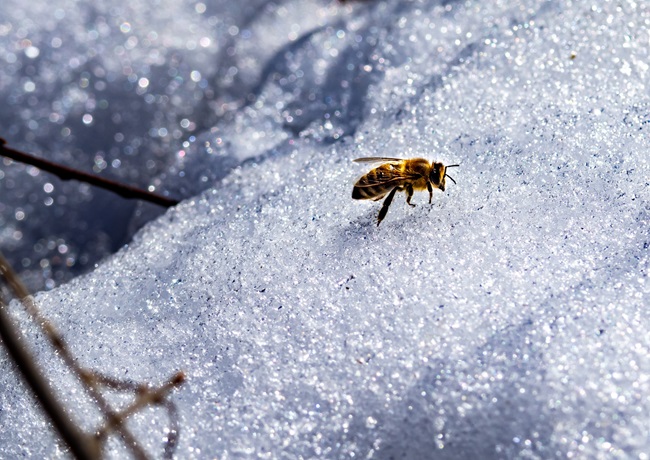
Ever wondered about how bugs make it through the winter? It’s not uncommon to see a line of ants marching up the sidewalk in the summer, but you won’t see the same colony going up and down through snowbanks in the winter. You’d think that due to their small size, insects wouldn’t hold up well in cold weather. And you’re correct! Insects that do not have specific adaptations to deal with the cold can freeze to death in as little as 24 hours when exposed to freezing temperatures. This effect is compounded when you account for the fact that typical insect food (pollen, nectar, leaves, etc.) is no longer available in the winter.
Yet come spring, all these insects are back out in full force with no noticeable decrease in numbers. So, what’s the trick? For some insects, like butterflies, the answer is to leave for warmer weather. These insects have no special resistance or adaptations to the cold, so their answer is to get away from it. Species of insects that migrate are butterflies, dragonflies, moths, and beetles.
Of course, wings are necessary for migration, and not every insect with wings chooses to migrate. What do the remainder do?
Hibernation is a common strategy for insects. Burrowing deep into the soil, finding leaf litter, crawling into a cave, and even going within your home! In fact, human homes are one of the easiest ways for an insect to survive the winter. After all, while the outside might be below freezing, your house is climate-controlled year round (Looking for more information on pests inside your home? Check out one of our previous articles). For insects unable to punch their ticket in your home, natural shelters reduce the severity of cold temperatures but do not remove them entirely. To survive the winter, insects must avoid having ice form within their cells. There are two methods for doing this: freeze avoidance and freeze tolerance.
Freeze avoidance, as the name implies, means that the insect does everything it can to avoid getting frozen. To do this, freeze avoidant insects produce a chemical within their bodies that is virtually identical to antifreeze. Yes, the same antifreeze that you put in your car! This chemical keeps fluids circulating throughout the insect’s body even when temperatures are below freezing. Freeze avoidant insects will also produce proteins that bond with ice crystals forming inside their bodies and break them down.
Some insects don’t bother with exerting energy to prevent themselves from freezing. Instead, they’ve evolved freeze tolerance, which means that these insects allow themselves to freeze and cope with the formation of ice crystals in their bodies. This type of insect is commonly found in the Southern Hemisphere, likely due to the more severe swings in climate.
It’s difficult to imagine turning yourself into a popsicle for the winter then waking up just fine in the spring. What needs to happen so the insect doesn’t die? First, ice just doesn’t form anywhere. The insect keeps any freezing outside of its cells through the creation of ice nucleating proteins. These proteins attract ice crystals, causing them to form on the outside of the body instead of inside cells. Freeze tolerant insects also attract water into their bodies. This prevents ice crystals from extracting water from the insect’s cells.
Finally, one of the most common winter adaptation strategies for insects isn’t necessarily what we’d think of as an adaptation. Countless species of short-lived insects don’t even live for one month in ideal weather. If this is the case, why evolve to live through the most difficult part of the year? Instead, these insects lay eggs before dying out in the fall. Once warmer weather appears, these eggs are triggered to hatch, as warm weather implies the existence of food for the larvae.
Regardless of how they do it, insects will find a way to make it through the winter. Even if you don’t see them when there’s snow on the ground, know that they’ll be back in the spring.
ARBICO Organics was founded in 1979 in Arizona. Over 40 years later, ARBICO Organics continues to produce innovative means of natural biological pest control for a wide range of consumers. Their product line up ranges from environmentally friendly solutions to common garden pests to biological powerhouses used in professional agriculture and at racetracks.



Comment here